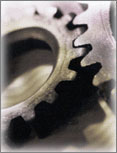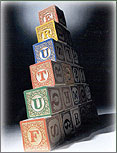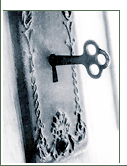 Overview:
One of the most common estate planning
strategies for married individuals
is for each spouse to leave his
or her entire estate to the surviving
spouse. Due to the unlimited marital
deduction, an entire estate (regardless
of size) can pass to the surviving
spouse without incurring any federal
estate taxes upon the first death.
However, such a strategy fails to
take advantage of the applicable
exclusion amount of $1,500,000 for
2004 (increasing to $3,500,000 by
2009) that each individual can transfer
to heirs completely free of gift
or estate taxes, potentially subjecting
the survivor's estate to higher
than necessary future taxes. This
undesirable situation occurs because
all property remaining in the survivor's
estate will otherwise be subject
to estate taxation. Overview:
One of the most common estate planning
strategies for married individuals
is for each spouse to leave his
or her entire estate to the surviving
spouse. Due to the unlimited marital
deduction, an entire estate (regardless
of size) can pass to the surviving
spouse without incurring any federal
estate taxes upon the first death.
However, such a strategy fails to
take advantage of the applicable
exclusion amount of $1,500,000 for
2004 (increasing to $3,500,000 by
2009) that each individual can transfer
to heirs completely free of gift
or estate taxes, potentially subjecting
the survivor's estate to higher
than necessary future taxes. This
undesirable situation occurs because
all property remaining in the survivor's
estate will otherwise be subject
to estate taxation.
One of the popular trust arrangements
designed to remedy this problem
in advance is the common "A/B"
combination, typically set up as
revocable trusts that can be modified
at any time prior to death. However,
there is another option known as
a qualified disclaimer, that can
provide some flexibility after a
spouse has died.
How much do you know about qualified
disclaimers?
Take this short quiz now or later!
- True or False. This planning
technique may be useful in situations
where proper arrangements were
not established prior to death.
- Which of the following is not
a requirement for a disclaimer
to qualify for federal tax purposes:
- The disclaimer must be in
writing and must be irrevocable;
- The disclaimed interest
must pass according to the
direction of the person disclaiming
the property;
- With the exception of a
spouse, the person disclaiming
the property cannot receive
any benefit from the disclaimed
property, such as trust income;
or
- None of the above.
- True or False. Any decision
to disclaim an inheritance should
be carefully reviewed to determine
if such a decision is consistent
with the overall goals and objectives
of the disclaimant.
Read here to learn more about
qualified disclaimers.
This post-mortem planning technique
may be useful in situations where
"A/B" trusts or similar
arrangements were not established
prior to death. Rather than transfer
all property to the surviving spouse
using the unlimited marital deduction,
thereby wasting the first spouse's
applicable exclusion amount, the
surviving spouse can disclaim a
portion of his or her inherited
property. The disclaimed property
then passes to other heirs or beneficiaries
as if the surviving spouse had predeceased.
The estate can then take advantage
of the applicable exclusion amount
with respect to the disclaimed property.
In order to be effective for federal
tax purposes, a disclaimer must
meet the following requirements.
- The disclaimer must be in writing
and must be irrevocable;
- The disclaimed interest must
pass without direction by the
person disclaiming the property.
Consequently, before deciding
to disclaim, it is advisable to
know who, under the will or applicable
state laws, will receive the property
instead. Typically, a will can
direct the disposition of any
disclaimed property;
- The written refusal must be
received by the grantor of the
interest (or the grantor's estate)
within nine months of the taxable
transfer creating the interest
(or, where the disclaimant is
a minor, within nine months of
the disclaimant's 21st birthday);
- and With the exception of a
spouse, the person disclaiming
the property cannot receive any
benefit from the disclaimed property,
such as trust income.
Spouse's Special Exemption
If the surviving spouse wants to
take advantage of this planning
technique, yet desires a lifetime
income from the disclaimed property,
a provision in the decedent's will
could accomplish this feat by establishing
a disclaimer trust. With this alternative,
the surviving spouse can effectively
establish an "A/B" trust
after the death of the first spouse.
Disclaiming an inheritance might
prove useful in certain situations.
For example, suppose your wealthy
uncle, a widower without children,
has named you as the beneficiary
of his entire estate, but has also
stipulated that should you die before
him, his estate will be distributed
to your children. Sadly, your uncle
passes away unexpectedly, and at
a time when you are financially
comfortable and really don't need
the money. Accepting your inheritance
will just increase the value of
your estate, and, hence, your potential
tax bill, when it ultimately passes
to your children. A better alternative
might be to benefit your children
today by disclaiming the inheritance,
with no associated gift tax imposed
as a result of the transfer assuming
all qualified disclaimer requirements
are satisfied.
Proceed with Caution
Be aware that there are instances,
such as in smaller-sized estates
for which a surviving spouse's standard
of living will be dependent upon
all of his or her assets, where
a qualified disclaimer may not be
an appropriate planning choice.
In addition, if the property in
question is of substantial value
and is transferred to an individual
two or more generations younger
than the donor, a disclaimer could
trigger generation-skipping transfer
taxes (generally levied on property
transfers valued above $1,120,000
per individual in 2004, indexed
for inflation).
 Nevertheless,
under the appropriate circumstances,
a qualified disclaimer may be an
effective tool to assist in reducing
the effects of transfer taxes. Remember,
however, that any decision to disclaim
an inheritance should be carefully
reviewed in advance with a qualified
legal professional to determine
if such a decision is consistent
with your overall goals and objectives. Nevertheless,
under the appropriate circumstances,
a qualified disclaimer may be an
effective tool to assist in reducing
the effects of transfer taxes. Remember,
however, that any decision to disclaim
an inheritance should be carefully
reviewed in advance with a qualified
legal professional to determine
if such a decision is consistent
with your overall goals and objectives.
Quiz Answers: 1) True; 2) b; 3)
True.

 Estate
planning has traditionally focused
on minimizing estate taxes and directing
the disposition of your assets after
death. Yet, in today's modern world,
managing your affairs has become
even more complicated as issues
involving health care and personal
finances, which can arise during
your lifetime, have become increasingly
more important. Estate
planning has traditionally focused
on minimizing estate taxes and directing
the disposition of your assets after
death. Yet, in today's modern world,
managing your affairs has become
even more complicated as issues
involving health care and personal
finances, which can arise during
your lifetime, have become increasingly
more important.

Consider what would happen if you
were to suffer a catastrophic illness
or become incapable of managing
your own affairs. This situation
could occur either through a long,
gradual process, such as a deteriorating
medical condition, or through a
sudden and unexpected accident or
illness. If such an event were to
happen, who would make your important
legal, financial, and health care
decisions? On what authority would
this individual act?
Fortunately, there are some estate
planning tools called advance directives
that can help in dealing with these
contingencies.
Legal and Financial Decisions
A durable power of attorney grants
authority to another person to make
legal and financial decisions on
your behalf in the event of mental
incapacity. The powers granted can
be broad or limited in scope. Some
decisions a durable power of attorney
can assist you with include your
personal finances, insurance policies,
government benefits, estate plans,
retirement plans, and business interests
Health Care Decisions
In the area of health care decision-making,
you may recall the Karen Ann Quinlan
case. In 1979, the New Jersey Supreme
Court granted permission to her
family to disconnect Karen's respirator,
which her doctors believed was prolonging
her life in a vegetative state.
The case led to the enactment by
various states of Natural Death
Act Declarations (i.e., living wills).
A living will generally allows
you to state your preferences prior
to incompetency regarding the giving
or withholding of life-sustaining
medical treatment. In most states,
you must have a "terminal condition,"
be in a "persistent vegetative
state," or be "permanently
unconscious" before life-support
can be withdrawn. The definition
of these terms and the medical conditions
covered may vary from state to state.
A health care proxy allows you
to appoint an agent to make health
care decisions on your behalf in
the event of incapacity. These medical
decisions are not limited to those
regarding artificial life-support.
 Advance
directives by durable power of attorney,
living will, or health care proxy
are generally inexpensive, easy
to implement, and should be considered
essential estate planning tools
for all individuals, regardless
of age. In the absence of such documents,
court intervention involving a great
deal of time, expense, and possibly
stress to your family, may be necessary
to carry out your legal, financial,
and health care wishes at precisely
the moment when timeliness and ease
of action are of the greatest importance. Advance
directives by durable power of attorney,
living will, or health care proxy
are generally inexpensive, easy
to implement, and should be considered
essential estate planning tools
for all individuals, regardless
of age. In the absence of such documents,
court intervention involving a great
deal of time, expense, and possibly
stress to your family, may be necessary
to carry out your legal, financial,
and health care wishes at precisely
the moment when timeliness and ease
of action are of the greatest importance.

 Historically,
estate planning has focused on the
minimization of taxes and the disposition
of one's assets at death. However,
managing one's affairs in the modern
world has become more complicated,
and quality of life issues (involving
health care, finances, and how critical
planning decisions are made) are
becoming more important. Historically,
estate planning has focused on the
minimization of taxes and the disposition
of one's assets at death. However,
managing one's affairs in the modern
world has become more complicated,
and quality of life issues (involving
health care, finances, and how critical
planning decisions are made) are
becoming more important.

Consider what might happen in the
event of catastrophic illness or
incapacity. How, and by whom, would
important financial decisions be
made? How, and by whom, would important
health care decisions be made? Such
an event could be either a long
gradual process (e.g., a deteriorating
medical condition) or something
which happens precipitously (e.g.,
a serious accident). Estate planning
tools that can provide instructions
for certain lifetime contingencies
are called advance directives.
One mechanism that can provide
for financial decision-making is
a power of attorney. This agreement,
entered into voluntarily, grants
authority to another person to make
legal decisions on one's behalf.
The person to whom the authority
is given is called the attorney
in fact (generally must be an adult)
who can act as the principal's surrogate
or agent. The powers granted can
be broad or limited in scope, depending
on the desires of the principal
(the person granting the power),
and can include such areas as insurance
transactions, estate transactions,
investment decisions, government
benefits, and retirement plan decisions.
Making the Document Binding
There are two aspects critical
to assuring maximum benefit from
setting up a power of attorney.
First, the principal must have sufficient
mental capacity at the time the
document is drawn to make it binding
in law. This means that the individual
must understand the nature and effect
of the document, much the same as
required for other legally binding
documents.
Second, if you want to use a power
of attorney in the event of incapacity,
the document must be a durable power
of attorney. A durable power of
attorney will remain in full force
even upon subsequent mental incapacity
of the principal. While this may
seem obvious (the document remaining
effective when it is most needed),
it was not long ago that a power
of attorney terminated upon incapacity.
Now, all 50 states have statutes
providing for a durable power of
attorney. The expressed language
must convey the idea that the powers
granted in the document will not
be affected by the principal`s subsequent
disability.
In most states, there is a presumption
that a power of attorney is not
intended to be durable unless specific
"durable" language is
included. Additionally, state requirements
can vary, making familiarity withindividual
state statutes important. For example,
Florida restricts who can be the
attorney in fact, limiting the designation
to a close blood relative. Some
states also require that the document
be witnessed or notarized. Not all
states recognize a springing durable
power of attorney (discussed below).
Choosing a Trigger Mechanism
Sometimes, the principal may want
to have the power of attorney take
effect only if and when mental incapacity
occurs. In such a case, a springing
durable power of attorney can be
used, which becomes effective only
upon the occurrence of a specific
contingency (e.g., certification
by a physician that management of
one's financial affairs is no longer
possible).
A springing durable power of attorney
assures that the principal will
not be relinquishing important rights
while still able to make independent
decisions. In crafting a springing
durable power of attorney, the method
of determining the triggering event
(e.g., defining mental incapacity)
should be carefully spelled out.
(For example, relying on a court
determination of incapacity would
defeat one of the benefits of using
a power of attorney, namely, avoiding
court intervention.)
 A
durable power of attorney is generally
inexpensive, easy to implement,
and should be considered an essential
estate planning tool for all individuals,
regardless of age. In the absence
of such a document, court intervention
(with the accompanying time and
expense) may be necessary to carry
out one`s financial desires at precisely
the moment when facility and timeliness
are paramount. A
durable power of attorney is generally
inexpensive, easy to implement,
and should be considered an essential
estate planning tool for all individuals,
regardless of age. In the absence
of such a document, court intervention
(with the accompanying time and
expense) may be necessary to carry
out one`s financial desires at precisely
the moment when facility and timeliness
are paramount.

 Part
I of this series looked at the durable
power of attorney as an estate planning
tool to direct financial quality
of life decisions, designating an
agent to act on one`s behalf when
one is no longer able to do so.
However, there are other issues
which may be just as important as
financial decisions, revolving around
what kinds of health care measures
will be taken (to alleviate suffering
or prolong life) if one is incapacitated.
How, and by whom, such health care
quality of life decisions will be
made can be addressed using additional
advance directives: living wills
and health care proxies. Part
I of this series looked at the durable
power of attorney as an estate planning
tool to direct financial quality
of life decisions, designating an
agent to act on one`s behalf when
one is no longer able to do so.
However, there are other issues
which may be just as important as
financial decisions, revolving around
what kinds of health care measures
will be taken (to alleviate suffering
or prolong life) if one is incapacitated.
How, and by whom, such health care
quality of life decisions will be
made can be addressed using additional
advance directives: living wills
and health care proxies.

First, Some History
In the area of health care decision-making,
you may recall the Karen Ann Quinlan
case. In 1979, the New Jersey Supreme
Court granted permission to the
Quinlan family to discontinue Karen's
respirator which her doctors believed
was prolonging her life in a vegetative
state. This case led to the enactment
by various states of Natural Death
Act Declarations (i.e., living wills).
More recently, in the Nancy Beth
Cruzan case (1990), the U.S. Supreme
Court affirmed that a person's right
to refuse treatment is guaranteed
by the Constitution, but held that
individual states had the right
to determine the criteria for providing
or withdrawing life sustaining treatment.
(Nancy Cruzan, permanently incapacitated
from an accident, had discussed
her feelings about prolonging life
with family and friends, but had
not committed her thoughts to writing.
Missouri required clear and convincing
evidence--i.e., a written document.)
The Quinlan and Cruzan cases suggest
that instructions of a formally
appointed health care agent must
be followed, provided such directives
are consistent with individual state
guidelines. While definitions vary
from state to state, over 40 states
now have living will statutes, allowing
individuals to provide instructions
regarding life sustaining measures
in the event of a terminal illness,
including (in some states) coma
or persistent vegetative state.
Also, in 1991, the Federal Patient
Self-Determination Act was passed,
requiring all Medicare and Medicaid
health care providers to inform
recipients of their rights (under
various court decisions and state
statutes) to accept or refuse medical
treatment, and of the right to set
up advance health care directives.
Living Wills vs. Health Care Proxies
A living will is a set of instructions
for a health care provider, stipulating
the extent to which measures should
be taken (consistent with state
statutes) to maintain one's life,
should incapacitation render the
person unable to express his or
her wishes. A health care proxy
(also called a health care power
of attorney in some states) appoints
an agent to make any and all health
care decisions, in effect implementing
instructions, on one's behalf in
the event of incapacity (a life
threatening condition, or where
the individual is unconscious and
a treatment decision must be made).
Since the health care proxy grants
decision-making power to a surrogate,
its scope is broader than the living
will which simply states a person's
wishes in the face of terminal illness.
The documents may be drawn separately,
or the living will may be incorporated
into the health care proxy, depending
on state law. Both directives come
into play only when the principal
is unable to make health care decisions
for him or herself.
Up until that point, the individual
maintains decision-making authority
with respect to health care. Usually,
an individual can change or revoke
both directives at any time. Some
states have also enacted Default
Surrogate Decision Making Statutes
which define a priority of individuals
who are empowered to act on behalf
of a person who did not execute
advance directives prior to incompetency.
Into the Future
 These
quality of life issues have become
further complicated by the controversy
surrounding the physician-assisted
death movement and ongoing "Death
with Dignity" voter initiatives.
(One particularly important unresolved
issue which could affect the use
of living wills is the definition
of "suicide" for insurance
purposes.) These
quality of life issues have become
further complicated by the controversy
surrounding the physician-assisted
death movement and ongoing "Death
with Dignity" voter initiatives.
(One particularly important unresolved
issue which could affect the use
of living wills is the definition
of "suicide" for insurance
purposes.)
Despite such controversies, not
only are one's personal wishes at
stake, but also the potential emotional
and financial burden placed on family
members by a medical condition with
no hope of recovery. Advance directives
can allow an individual to maintain
autonomy, while providing specific
instructions to assure that his
or her wishes are carried out to
the fullest extent possible.

 Over
the past ten years, owners of nursing
homes have seen a steady decline
in the occupancy rates of their
facilities. There are a number of
reasons for this historic drop.
One significant reason is that the
number of "home care agencies"
has increased, thus allowing the
less disabled to remain in their
homes. Another reason is that Medicaid
waivers have siphoned off long-term
care patients in some states by
paying for limited home care, thus
saving states the higher costs of
institutional care. In addition,
Medicare also began paying nursing
homes more to admit hospital patients
for rehabilitation. There is also
another explanation for the increase
of empty beds in today's nursing
homes-assisted living facilities
(ALFs). Over
the past ten years, owners of nursing
homes have seen a steady decline
in the occupancy rates of their
facilities. There are a number of
reasons for this historic drop.
One significant reason is that the
number of "home care agencies"
has increased, thus allowing the
less disabled to remain in their
homes. Another reason is that Medicaid
waivers have siphoned off long-term
care patients in some states by
paying for limited home care, thus
saving states the higher costs of
institutional care. In addition,
Medicare also began paying nursing
homes more to admit hospital patients
for rehabilitation. There is also
another explanation for the increase
of empty beds in today's nursing
homes-assisted living facilities
(ALFs).
Assisted Living: The Future of
Residential LTC
Assisted living facilities (ALFs)
include apartments, usually with
small kitchens, coupled with the
provisions of personal assistance
for some disabilities. It's easy
to appreciate the difference between
these facilities and traditional
nursing homes that normally put
two residents into each small, sterile
room.
ALFs range in quality for those
offering top-end accommodations
and amenities to lower priced, but
quality, operations.
Formal assisted living must be
distinguished from board and care
homes. The latter tend to be "mom
and pop" operations, often
consisting of private residences
managed either by either the owner
or someone who lives on the premises,
and who provides care. The quality
of care in ALFs is often considerably
better due to the substantially
greater privacy, freedom, and amenities
than those possible in traditional
long-term care settings, or traditional
nursing homes.
Assisted Living is Often Less
Expensive Than The Nursing Home
While prices for ALFs vary according
to quality, services, and amenities,
they tend to be less expensive than
nursing homes. Some facilities'
fees cover personal care, others
may not. If you ever consider an
ALF for yourself or a relative,
be sure to review the contract carefully
to find out what is covered, and
what is not, before you sign. And
remember, it could be a mistake
to make a decision purely on your
cost. Today's long-term care insurance
policies generally cover assisted
living. There may be some limitations
involved, so it's important to understand
the impact of all policy benefits
and conditions.
A Word of Caution
 ALFs
may not be for everyone who needs
long-term care. Granted, they are
generally the more qualitative alternative
to nursing homes, however, they
are designed only to care for the
lightly to moderately impaired.
If a person is seriously impaired,
a nursing home is often the best
choice. On the other hand, some
people who need long-term care neither
need, nor prefer, either an ALF
or a nursing home. They can receive
care at home, both from relatives
and friends and from paid, trained
home care personnel. How do you
know which type of care is best
for you or a loved one? Most long-term
care policies today provide a care
coordinator to assist you in making
the right decision regarding the
type and place of care best suited
to your needs. Again, check your
policy or ask your agent if your
policy pays for a care coordinator. ALFs
may not be for everyone who needs
long-term care. Granted, they are
generally the more qualitative alternative
to nursing homes, however, they
are designed only to care for the
lightly to moderately impaired.
If a person is seriously impaired,
a nursing home is often the best
choice. On the other hand, some
people who need long-term care neither
need, nor prefer, either an ALF
or a nursing home. They can receive
care at home, both from relatives
and friends and from paid, trained
home care personnel. How do you
know which type of care is best
for you or a loved one? Most long-term
care policies today provide a care
coordinator to assist you in making
the right decision regarding the
type and place of care best suited
to your needs. Again, check your
policy or ask your agent if your
policy pays for a care coordinator.

Life in America today commonly
finds families scattered across
the country. With family members
often separated by hundreds or thousands
of miles, it may be extremely difficult
to manage the care of an older parent
or relative living far away. To
help facilitate the best care possible
for your loved one, and to alleviate
the stress long distance caretaking
could cause, you may want to take
steps now to be prepared, should
the need arise.
Down to Basics
As a first step, look into what
services are available in your family
member’s local community. Most areas
have government or nonprofit agencies
to provide assistance and referrals.
Once appropriate providers have
been identified, consider making
use of services that can assist
with the desired needs, such as
managing finances, drafting or amending
a will, or preparing advance directives
(e.g., durable power of attorney,
health care proxy, and living will).
When properly prepared, the following
legal documents can provide essential
protection and, therefore, should
be prepared without delay:
- A will provides instructions
for distributing assets and providing
for the needs of heirs, while
aiming to reduce probate expenses.
- A durable power of attorney
authorizes a third party to manage
the financial and legal affairs
of a person who is no longer capable
of doing so.
- For making decisions concerning
health care, a living will is
a set of instructions for health
care providers that stipulates
the extent to which measures should
be taken (consistent with state
statutes) to sustain the patient’s
life should the person be unable
to express his or her wishes.
In some states, the patient’s
condition must be considered “terminal”
under state laws before a living
will becomes effective.
- A health care proxy allows an
individual to designate a person
to make critical medical decisions
in the event the individual is
incapable of directing his or
her own health care. Unlike a
living will, it is not limited
to decisions regarding artificial
life-support.
Get Organized
Once you know where to turn for
assistance, it will be helpful to
gather and organize the following
information about your loved one:
- General Assessment and Support—Keep
notes on the current mental and
physical condition of the individual
and compare your observations
with those of other family members.
Identify neighbors or friends
who could keep an eye out for
your loved one and who would be
willing and able to help in a
pinch. List agencies located near
your relative that provide specific
services and support he or she
may need in an emergency.
- Medical Information—Identify
all pertinent doctors, hospitals,
and other medical providers. In
addition, keep track of all medications
and health insurance policy numbers.
- Financial and Legal Information—Obtain
copies of all financial and legal
documents, including wills, advance
directives, insurance policies,
bank accounts, and other financial
statements. Record all relevant
account and Social Security numbers.
Take Action now
A variety of resources are available
to assist in the care of older parents
and relatives. Begin planning now
to make the best use of them. When
it comes to preparing advance directives
and handling other estate planning
matters, it is generally prudent
to consult a qualified legal professional.
Your efforts now can help ease future
stress for family caregivers and
help provide the most comfortable
life for your loved one.

A charitable remainder trust (CRT)
can be a highly effective, financial
and estate planning tool through
which one can: avoid capital gains
taxes on highly appreciated assets;
receive a stream of income based
on the full, fair market value of
those assets; receive an immediate
charitable deduction; and ultimately
benefit the charity(ies) of one’s
choice.
Some individuals may be reluctant
to transfer significant assets to
a CRT because they would rather
see their children be the ultimate
recipients of the property. However,
transferring property to a CRT doesn’t
necessarily mean your children cannot
benefit as well.
Under the appropriate circumstances,
donors can apply the savings available
from their charitable deduction,
along with a portion of the CRT’s
income stream if necessary, to purchase
a life insurance policy inside an
irrevocable life insurance trust
(ILIT). After the death of the last
income beneficiary, the charity
receives the remaining assets in
the CRT, while your children receive
the proceeds of the life insurance
policy, income and estate tax free,
upon the death of the insured in
accordance with the terms of the
ILIT. In some instances, policy
proceeds may be equal to, or even
exceed, the value of the transferred
property.
General Guidelines
A CRT starts with a contribution
of assets, preferably highly appreciated
assets, into an irrevocable trust.
Once the trust is funded, the trustee
pays named beneficiaries (selected
by the donor upon establishment)
an income each year for their lives,
a term of years, or a combination
of the two. If a term of years is
involved, the maximum term is 20
years. Income beneficiaries must
receive a minimum percentage payout
each year equal to at least 5 percent
of the trust’s assets, not to exceed
50 percent. When the trust terminates,
the remaining assets that pass to
charity must be equal to at least
10 percent of the original assets
in the trust. Within these broad
guidelines, donors can select a
number of flexible payment options
designed to meet their specific
financial, estate, and charitable
giving objectives.
Additional Benefits
Because a CRT is tax exempt, the
trustee can sell highly appreciated
assets on a tax-free basis and reinvest
the full proceeds in other assets
most likely to meet the growth and
income objectives of the trust.
Assets donated to the trust are
removed from the donor’s taxable
estate, potentially avoiding significant
future estate taxation and likely
reducing future probate costs. Donated
assets are also protected from the
claims of creditors, which may be
particularly attractive to business
owners concerned about their personal
liability or perhaps those who are
sensitive to issues related to the
division of assets in a divorce.
The charitable deduction available
to a donor may be limited by the
type of property donated, the kind
of organization(s) ultimately receiving
the gift, the donor’s overall tax
status, the age(s) of the income
beneficiary(ies), and the trust’s
income payout provisions. If a deduction
is limited on the current year’s
tax return, Internal Revenue Service
(IRS) rules allow unused amounts
to carry forward for up to five
additional, consecutive tax years.
Moreover, since donations of appreciated
property are no longer preference
items for the alternative minimum
tax (AMT), donating such property
may now be much more advantageous.
(Under prior law, the AMT could,
in many cases, have significantly
trimmed the potential income tax
deduction available for donations
of appreciated property.)
The Choice is Yours
While most people may be resigned
to the inevitability of taxation,
one way or another, many may be
unaware that they have a choice
with respect to the form in which
their contribution to society is
fulfilled. When viewed from the
perspective of a choice to channel
your funds directly to select charities
rather than through the government,
charitable giving takes on a new
meaning. The CRT may then become
a valuable tool to facilitate your
choice. As with all complex financial
transactions, the assistance and
counsel of qualified professionals
is highly recommended in order to
ensure your wishes are properly
met.

 Liquidating
the family business in order to
pay estate taxes is often a grim
reality for families of individuals
who die without wills or estate
plans. Liquidating
the family business in order to
pay estate taxes is often a grim
reality for families of individuals
who die without wills or estate
plans.
If you own a family business, you
need to take steps now to help ensure
that one of your most valuable assets
will still be around for your children,
grandchildren, and beyond.



|
The facts on family-owned
businesses.
The terms "family business"
or "small business"
can be misleading, especially
when you consider the impact
these businesses have on the
U.S. economy. Of all small
companies in the U.S. employing
fewer than 500 people, 88%
are owned by families. According
to an estimate by the National
Family Business Council (NFBC),
12.9 million family-owned
U.S. businesses generate 60%
of the gross national product
and employ 40 to 50 million
people.
It's natural to assume that
many business owners would
like to keep this kind of
influence in the family. However,
in reality, the situation
is much different: only a
fraction of business owners
who want their family business
to remain in the family actually
take steps to plan a formal
succession, according to the
Boston-based Family Firm Institute.
Why do so many business owners
fail to act on their intentions?
Because business continuation
is often a difficult subject
for family business owners
to confront. In many cases,
the subject of succession
is avoided rather than planned
for. It is often a taboo topic.
Business owners may be reluctant
to hand over something they
spent much of their lives
building. They may be forced
to confront and resolve sibling
rivalry and other unpleasant
family disagreements. Sometimes
an owner will have greater
difficulty grooming a family
member for succession because
of the overlap of family and
business boundaries. Additionally,
if the owners plan to rely
on the family business for
retirement income, they may
worry about the business's
success under new owners.
But the costs of not planning
for the continuation of family
businesses may be enormous.
Often, companies without formal
succession plans are courting
disaster. NFBC statistics
show:
- Only 4 in 10 family businesses
survive into the second
generation.
- Only 1.5 in 10 survive
into the third generation.
Survival planning for your
family business
How can you make sure that
your business avoids becoming
one of these statistics? A
sound solution is to establish
an estate plan. Simply put,
you need to:
- Develop a formal management
succession strategy and
ensure that your business
stays in the family after
your death.
- Equalize your estate so
that if you have children,
you can make alternative
bequests to those who do
not want to be involved
with the family business.
At the same time, you can
leave the business to the
children who do.
- Guarantee that the business
continues in an orderly
manner after your death.
- Create a buy-sell agreement
for family and non-family
members who may own stock
in your business
|
 As
you can see, ensuring that your
business lives on is a complicated
issue that engenders many concerns,
and care must be taken to ensure
that all issues will receive open
and honest discussion. With the
right estate planning team and the
right succession plan in place,
you can go against the statistics
to maintain your company's success
and ensure your family's ownership
for future generations. As
you can see, ensuring that your
business lives on is a complicated
issue that engenders many concerns,
and care must be taken to ensure
that all issues will receive open
and honest discussion. With the
right estate planning team and the
right succession plan in place,
you can go against the statistics
to maintain your company's success
and ensure your family's ownership
for future generations.

 Overview:
Parents of a special needs child
have never ending concerns about
their child’s care. For instance,
where will the child live should
something happen to his or her parents?
Who will care for the child, and
where will the money come from? Overview:
Parents of a special needs child
have never ending concerns about
their child’s care. For instance,
where will the child live should
something happen to his or her parents?
Who will care for the child, and
where will the money come from?

How much do you know about financial
planning for a special needs child?
Take
this short quiz now or later.
 |
- True or False. The plan
that is often most helpful
for families needing to
make provisions for a child
with special needs is a
grantor retained annuity
trust. This device allows
a trustee, typically a family
member familiar with the
child's needs, to use funds
placed in a trust by the
child’s parents for the
necessary care.
- True or False. A charitable
remainder trust can be a
favorable planning mechanism
for the parents of a special
needs child.
- True or False. If a charitable
remainder trust is used
and a minor child is the
income beneficiary, any
income tax deduction could
be drastically reduced because
of life expectancy differences.
|
Read here to learn more about
financial planning for a special
needs child
Fortunately, help is available,
with local, state, and federal programs
easing some of the monetary demands
on the family. In addition, there
are private groups that can help
with long-term care. However, if
you wish to provide the highest
level of care, you will need to
plan for the best possible use of
your funds.
Meeting Needs
The plan that is often most helpful
for families needing to make provisions
for a child with special needs is
a special needs trust. This device
allows a trustee, typically a family
member familiar with the child's
needs, to use funds placed in a
trust by the child’s parents for
the necessary care. It offers sufficient
flexibility to handle almost any
situation, while providing privacy
for the details of the arrangements
made by parents, grandparents, or
others who wish to make a gift to
a special needs child.
Many people may assume that trusts
are only for the very wealthy, however,
a special needs family’s financial
situation demands prudent planning
to prevent loss of agency funding
after the parents are gone. For
example, assets received as an inheritance
might disqualify an adult child
from receiving public funding for
housing, medical care, and other
government programs. Assets placed
in a trust, however, and directed
to uses other than those available
through government sponsorship remain
available for the individualized
care a parent might want to provide.
While the special needs trust can
establish a mechanism for maintaining
financial care for a special needs
child, some families have utilized
the charitable remainder trust (CRT)
as an additional mechanism to help
secure future income for a special
needs child. As its name implies,
a CRT benefits a charity as well
as an individual. Here’s how it
works:

A couple starts by transferring
liquid, highly appreciated assets,
such as mutual funds or publicly
traded stocks, into their CRT. The
couple receives an annual income
from the trust for a term of years
or their joint life expectancies.
The IRS allows the couple to take
a current income tax deduction for
the present value of the property
that ultimately passes to the charity
they selected-- generally one involved
with the special needs of the child--when
the CRT terminates. [Note: In the
case where a minor child is the
income beneficiary, this tax deduction
could be drastically reduced because
of life expectancy differences.]
Any property put into the trust
is out of the parents' estates,
and when the trust terminates, a
sizable legacy will be left to the
charity of their choice. In addition,
there is no capital gains taxes
due for transfers of highly appreciated
property to the CRT.
The use of a CRT to benefit a special
needs child may be advantageous
in many ways. The income stream
is used for the benefit of the child,
with either the child or the parents
as the named income beneficiaries.
If the child is the income beneficiary,
the trust can pay income for the
child's life, and the parents, as
financial guardians, will oversee
the use of the income. Should the
child outlive the parents, a guardian
will step into the parents' role.
A Parting Thought
 Certainly,
planning for a special needs child
is emotionally challenging and financially
demanding. However, with a solid
plan in place, you can help ensure
the best possible care for your
child, both now and in the future. Certainly,
planning for a special needs child
is emotionally challenging and financially
demanding. However, with a solid
plan in place, you can help ensure
the best possible care for your
child, both now and in the future.
Quiz Answers: 1) False; 2) True;
and 3) True

 If
you are like most people, wills,
trusts, life and disability income
insurance, and advance directives
are topics you would just as soon
avoid. Yet, timely planning is necessary
to preserve the assets you have
worked so hard to build and to protect
those you love. Here are some important
steps you can take now to ease your
family’s emotional and financial
burden in the event of your death: If
you are like most people, wills,
trusts, life and disability income
insurance, and advance directives
are topics you would just as soon
avoid. Yet, timely planning is necessary
to preserve the assets you have
worked so hard to build and to protect
those you love. Here are some important
steps you can take now to ease your
family’s emotional and financial
burden in the event of your death:
- Prepare a will. This document
specifies how you want your assets
to be distributed after your death.
If you die without a will (intestate),
your estate will be distributed
through the probate court according
to the intestacy laws of your
state. Intestacy laws essentially
function as a “one-size-fits-all”
will. Without a will, your assets
may or may not be transferred
to those you would have chosen.
In some cases, you must have a
will, such as if you wish to designate
an executor for your estate, name
guardians for minor children,
or appoint other fiduciaries.
- Consider a living trust. Also
called an inter vivos trust, a
living trust is established and
in effect during your lifetime.
It provides a mechanism to safekeep,
manage, and distribute your assets.
These trusts are revocable in
the sense that you retain complete
control of your assets and may
alter the trust at any time. Most
people establish living trusts
to avoid probate. Avoiding probate
may make sense for those who are
concerned about privacy, since
probated assets are a matter of
public record. It may also benefit
those who own property outside
their state of domicile, since
their estates might otherwise
be subject to multiple probate
proceedings. Once a trust is established,
assets must be transferred into
it or they may be subject to probate.
Keep in mind that a trust’s usefulness
depends on the type of property
involved (e.g., real estate, life
insurance, bank accounts, investments,
business interests, and personal
property), where it is located,
and how it is currently titled.
In addition, a living trust generally
does not eliminate the need for
a will.
- Title property for ease of transfer.
A simple and inexpensive estate
planning technique is to own property
as joint tenants. Many couples
do this, for instance, with their
personal residence. With jointly-owned
property, when one partner dies,
the property automatically passes
to the surviving partner without
going through probate. However,
it is important to note that community
property states have their own
laws governing the disposition
of assets.
- Purchase life and disability
income insurance. For a relatively
low cost, life insurance can help
provide a source of replacement
income for your family. The death
benefit may also be used to help
pay estate taxes or other immediate
financial obligations. According
to the Insurance Information Institute
(III, 2002), a working American,
at the age of 40, has a 21% chance
of becoming disabled for 90 days
or more before age 65. Disability
income insurance can help protect
the integrity of your family’s
finances.
- Establish advance directives.
It is essential to have a living
will, durable power of attorney,
and health care proxy in place
in case of a physical or mental
incapacity. A living will allows
you to express your preferences
regarding the giving or withholding
of life-sustaining medical treatment.
A durable power of attorney and
health care proxy allow you to
designate someone to handle your
legal and financial affairs and
make your medical decisions if
you are unable to do so. It is
also important to inform those
closest to you of your arrangements
and the whereabouts of the related
documents.
Consider taking these initiatives
now, while they are fresh on your
mind. The key to successful estate
preservation is planning!

If you’re like most individuals,
you probably want to ensure your
assets pass to your heirs in full
at the time of your death. However,
if you have a large estate, one
of the greatest financial challenges
potentially facing your heirs may
be the payment of estate taxes.
Have you given much consideration
to how your estate taxes will be
paid?
Generally, there are three methods
that can be used to raise money
to pay estate taxes:
- you can sell assets;
- you can take out a loan; or
- you can use life insurance.
Here’s a closer look at each option.

Selling assets.
Some liquid assets, (e.g., bank
accounts, publicly traded stocks,
and bonds) may be used to pay the
estate tax. However, sale of these
assets generally reduces the size
of the estate by the size of the
estate tax, dollar for dollar.
Sometimes the tax may be too large
for payment using only liquid assets.
In these cases, houses, real estate,
rental property, collectibles, and
other illiquid assets may have to
be sold to pay the tax. Assets,
including undervalued, publicly
traded securities, sold quickly
during a forced sale or at an auction,
usually sell well below potential
fair market values. Consequently,
your beneficiaries may potentially
receive an even smaller inheritance
than you may have initially planned.
Thus, selling assets may not be
the most appealing choice.
Borrowing the money.
Quite often, an executor may be
forced to borrow from a lending
institution in order to avoid the
forced liquidation of assets. The
repayment of a loan with interest
from assets of the estate will likely
result in beneficiaries also receiving
a smaller inheritance.
If you own a closely-held business,
estate taxes may be paid on an installment
method with low rates from the government—but,
it’s still a loan.
Discounted dollars.
Individuals often arrange for life
insurance to pay estate taxes. Theoretically,
each annualized premium may be only
a small fraction of the potential
death benefit proceeds. Therefore,
it’s often described as using "discounted
dollars" to pay the taxes because
it is anticipated the life insurance
policy proceeds will be greater
than the total premium outlay over
the life of the policy. In addition,
policy ownership can be arranged
so the policy proceeds will not
be included in the insured’s estate.
 As
a result, when compared to the alternatives,
life insurance is often regarded
as one of the most cost-effective
methods for funding the payment
of estate taxes. A consultation
with a qualified insurance professional
can help you assess your current
insurance needs and help you determine
how life insurance can fit into
your overall financial picture. As
a result, when compared to the alternatives,
life insurance is often regarded
as one of the most cost-effective
methods for funding the payment
of estate taxes. A consultation
with a qualified insurance professional
can help you assess your current
insurance needs and help you determine
how life insurance can fit into
your overall financial picture.

 For
many affluent individuals, estate
planning extends well beyond mere
tax planning and involves very personal
decisions regarding the distribution
of future wealth. In more traditional
estate plans, the so-called spendthrift
trust is used as a mechanism for
distributing trust income, while
limiting immediate access to trust
principal. For
many affluent individuals, estate
planning extends well beyond mere
tax planning and involves very personal
decisions regarding the distribution
of future wealth. In more traditional
estate plans, the so-called spendthrift
trust is used as a mechanism for
distributing trust income, while
limiting immediate access to trust
principal.
A spendthrift trust can provide
financial security and stability
for minor children, as well as protect
adult heirs from some creditors
and personal failures in judgment.
However, such trusts provide heirs
with little incentive to expand
their own professional, academic,
or philanthropic horizons. Thus,
affluent individuals who are particularly
sensitive to the potential ramifications
of “handing over” considerable wealth
to heirs may find comfort in adopting
an incentive-based estate plan.
One of the cornerstones of an incentive-based
estate plan is the Family Incentive
TrustTM (FIT). Like typical trusts
associated with estate planning,
a “FIT” serves as an outline that
guides trustees in the implementation
of an affluent grantor’s expectations
regarding the future uses of his
or her estate. Similarly, a FIT
can help ensure proper care and
financial support if an heir falls
on hard times or has special needs.
However, a FIT is somewhat unique
in that the general distribution
of trust income is rooted in a series
of pre-determined “incentives.
What is “The Incentive”?
The incentives outlined in a FIT
are virtually up to the imagination
of the grantor. Each incentive provides
the grantor with the ability to
encourage specific, future behavior.
For instance, the trust could have
provisions that pay each heir $10,000
upon the receipt of a bachelors
degree, $25,000 for a masters degree,
and $50,000 for a doctorate.
A FIT can also be an ideal mechanism
to reward family members who pursue
and/or distinguish themselves in
a favored career path of the grantor’s
choosing, such as the family business,
music, the arts, research, or teaching.
Or, a FIT can reward younger heirs
for academic success or community
involvement. In addition, the trust
could match certain levels of income
for heirs who are less than a specified
age (e.g., 35). A FIT also can be
an excellent education-funding vehicle.
Unlike a custodial account, which
generally becomes the property of
the child once he or she attains
the age of 18, a FIT can dictate
that some trust assets be utilized
to fund education costs. Thus, the
trust, rather than a young, inexperienced
adult, can maintain control of monies
earmarked for education.

Another interesting use of a FIT
is one that allows trust principal
to act as a “family bank.” The FIT
can offer low interest rate loans
for start-up business ventures or
the purchase of a primary residence.
A lending process similar to that
of a traditional lending institution
can be required to ensure minimal
risk to the trust.
Philanthropy creates another intriguing
possibility for an incentive-based
estate plan. Certainly, many affluent
individuals consider philanthropic
pursuits very important endeavors.
A FIT can be used to match the charitable
contributions of a beneficiary.
If so desired, the FIT’s matching
contribution can be arranged as
a distribution to the beneficiary,
which is then contributed to the
charity. Thus, the beneficiary can
reap the benefits of a charitable
deduction on both their own contribution,
as well as the FIT’s matching contribution.
Similarly, any remaining trust income
that has not been distributed through
incentives may make for an ideal
contribution to a family foundation
or charity. Such contributions also
can be arranged so they are made
on behalf of trust beneficiaries.
Instilling Family Culture
 Sometimes,
the effects of inherited wealth
can have a negative impact on the
motivation of heirs. For instance,
when some heirs receive a substantial
inheritance, they may be content
with a lifestyle of leisure. Thus,
the reasoning behind incentive-based
estate planning is fairly straightforward.
Assets and income are distributed
to assist heirs who are realizing
career or academic goals, and/or
whose actions are consistent with
the expectations of an affluent
grantor. By adopting some of the
principles of incentive-based estate
planning, the affluent grantor can
create an environment that promotes
a family culture of excellence and
productivity for generations to
come. Sometimes,
the effects of inherited wealth
can have a negative impact on the
motivation of heirs. For instance,
when some heirs receive a substantial
inheritance, they may be content
with a lifestyle of leisure. Thus,
the reasoning behind incentive-based
estate planning is fairly straightforward.
Assets and income are distributed
to assist heirs who are realizing
career or academic goals, and/or
whose actions are consistent with
the expectations of an affluent
grantor. By adopting some of the
principles of incentive-based estate
planning, the affluent grantor can
create an environment that promotes
a family culture of excellence and
productivity for generations to
come.

 It
is the duty of the probate court
to determine that a will is valid
and administer the estate to ensure
faithful execution of all instructions
found therein. Although most states
have exemptions for smaller estates,
the assets in your will ultimately
fall under the jurisdiction of the
probate court. It
is the duty of the probate court
to determine that a will is valid
and administer the estate to ensure
faithful execution of all instructions
found therein. Although most states
have exemptions for smaller estates,
the assets in your will ultimately
fall under the jurisdiction of the
probate court.
A trust, similar to a will, is
a written document dealing with
the transfer of assets and responsibilities,
but assets in certain types of trusts
can avoid the probate process.
Testamentary trusts are created
at death by a will; such trusts
must be presented for probate because
they are found within the will itself.
For assets in a trust to avoid probate,
the trust must be a “living” or
inter vivos trust, apart from a
will.
The probate process has advantages
and disadvantages. Analyze both
to determine how probate could affect
your estate plan. Some points to
consider:
Advantages of Probate
- Protection from creditors.
When an estate has been probated
and its assets distributed, no
creditor can make a claim on the
assets.
- Fair analysis of estate value.
If heirs believe property has
been overvalued in probate, thus
increasing the potential estate
tax, the lawyer or executor can
bring in an independent appraiser.
The judge may approve the new
appraisal or take a position between
the independent appraiser and
the court-appointed one.
- Protection from some taxation.
An estate is a separate taxable
entity and may provide opportunities
to reduce taxes by shifting income
to an heir, or--if the estate's
tax bracket is lower than the
heir's--keeping it in the estate
longer. 4. Lower cost of legal
counsel. It may cost more for
legal counsel to draft a living
trust than to draft a will.

Disadvantages of Probate
- Higher costs to the estate.
Probate can be costly; fees may
be set by law in some states,
but they are generally for ordinary
services. If the attorney does
extraordinary work, the fees may
be greater. The executor may also
charge fees and, if the executor
does not waive his or her fee,
the actual cost to the estate
may double. The fees may be based
on gross, not net, values.
- Delay in transfer of assets.
Estate settlement in probate can
take up to one or two years, and
assets in probate often suffer
from lack of (or overly conservative),
management during the settlement
process. In some states it can
take a month or more to receive
court permission to sell an asset,
which means that an executor may
be unable to respond to a sudden
change in market conditions. Also,
executors tend to be very conservative
during probate because of their
financial liability if they are
judged to be less than prudent.
- Public knowledge of the estate.
Probate is a public process. For
the process to work, the will
must be a matter of public record.
 It’s
important to recognize that probate
laws vary from state to state. By
using these pros and cons as a guide,
you can meet with your advisors
to determine whether to use or avoid
the probate process while planning
your estate. It’s
important to recognize that probate
laws vary from state to state. By
using these pros and cons as a guide,
you can meet with your advisors
to determine whether to use or avoid
the probate process while planning
your estate.

Conventionally, estate planning
has focused on how to minimize estate
taxes and “who gets what” when you
die. However, managing your affairs
in the modern world has become more
complicated and quality of life
issues involving health care, personal
finances, and how critical decisions
are to be made are becoming increasingly
more important.
Consider what might happen to your
financial affairs in the event of
catastrophic illness or incapacity.
How, and by whom, would important
financial decisions be made? How,
and by whom, would important health
care decisions be made? Such an
event could be either a long, gradual
process (e.g., a deteriorating medical
condition) or something that happens
precipitously (e.g., a serious accident).
Fortunately, there are some estate
planning tools that can provide
instructions for dealing with certain
lifetime contingencies-they are
called advance directives.
Financial Considerations
 One
mechanism that can provide for financial
decision-making is a durable power
of attorney. This agreement grants
authority to another person to make
legal decisions on one’s behalf
in the event of mental incapacity.
The powers granted can be broad
or limited in scope and can include
provisions pertaining to personal
finances including such concerns
as insurance coverage, tax planning
and reporting, government benefits,
and savings and retirement plan
decisions. One
mechanism that can provide for financial
decision-making is a durable power
of attorney. This agreement grants
authority to another person to make
legal decisions on one’s behalf
in the event of mental incapacity.
The powers granted can be broad
or limited in scope and can include
provisions pertaining to personal
finances including such concerns
as insurance coverage, tax planning
and reporting, government benefits,
and savings and retirement plan
decisions.
Health Care Considerations
In the area of health care decision-making,
a living will is a set of instructions
for a health care provider that
stipulates the extent to which measures
should be taken (consistent with
state statutes) to maintain the
patient’s life should the person
be unable to express his or her
wishes. You may recall the Karen
Ann Quinlan case from 1979 in which
the New Jersey Supreme Court granted
the Quinlans permission to discontinue
Karen’s respirator, which her doctors
believed was prolonging her life
in a vegetative state. The case
led to the enactment by various
states of Natural Death Act Declarations
(i.e., living wills). In some states,
the patient’s condition must be
considered “terminal” under the
state statutes before the living
will becomes effective.
A health care proxy appoints an
agent to make those health care
decisions and, unlike a living will,
is not limited to decisions regarding
artificial life-support. A health
care proxy comes into play only
when a person is unable to make
his or her own health care decisions.
Plan Ahead
 Advance
arrangements by living will or health
care proxy are relatively inexpensive,
easy to implement, and should be
considered essential estate planning
tools for all individuals, regardless
of age. In the absence of such documents,
court intervention (with the accompanying
time, expense, and possible stress
a family may endure) may be necessary
to carry out one’s financial and
health care desires at precisely
the moment when facility and timeliness
are paramount. Advance
arrangements by living will or health
care proxy are relatively inexpensive,
easy to implement, and should be
considered essential estate planning
tools for all individuals, regardless
of age. In the absence of such documents,
court intervention (with the accompanying
time, expense, and possible stress
a family may endure) may be necessary
to carry out one’s financial and
health care desires at precisely
the moment when facility and timeliness
are paramount.

 If
you are thinking about establishing
a living trust, you will also need
to give considerable thought to
selecting a trustee. Perhaps you
are considering naming a family
member. Or, you may be wondering
whether it would be wiser to designate
your attorney or another trusted
professional. In addition, you may
also be aware that a bank trust
department can act as a trustee.
As the grantor, you should choose
a trustee with care. Here is some
information on the role of a trustee,
and the benefits and tradeoffs of
the different choices available
to you. If
you are thinking about establishing
a living trust, you will also need
to give considerable thought to
selecting a trustee. Perhaps you
are considering naming a family
member. Or, you may be wondering
whether it would be wiser to designate
your attorney or another trusted
professional. In addition, you may
also be aware that a bank trust
department can act as a trustee.
As the grantor, you should choose
a trustee with care. Here is some
information on the role of a trustee,
and the benefits and tradeoffs of
the different choices available
to you.
A trustee is a person or an institution
selected to administer a trust.
A trustee's role is to comply with
the terms of the trust and fulfill
its objectives. In selecting a trustee,
you must weigh many personal, family,
investment, and business concerns.
For instance, an important consideration
is the size and complexity of the
trust. Corporate and professional
trustees possess the accounting,
tax planning, and investment experience
necessary to manage large, complicated
trusts. Bank trust departments offer
the benefits of greater portfolio
diversification, although they may
tend to invest more conservatively,
which may or may not appeal to you.
On the other hand, small trusts
generally do not warrant professional
management.
Duration is another significant
concern. A trustee's responsibilities
often span one or more generations.
Corporate fiduciaries have the advantage
of perpetual life (although the
individuals administering the trust
may change over the years). This
longevity also allows them to better
fulfill the record keeping and reporting
requirements of federal and state
governments and the supervising
court. If you have decided to appoint
only individual trustees, consider
designating co-trustees or successor
trustees to address longevity concerns.
Advantages of Professional Trustees
Corporate trustees have other advantages,
as well. Since they are more likely
to remain in the same location,
they may be more likely to stay
in close proximity to beneficiaries.
They may also be more impartial
in considering beneficiaries' needs
than family members, who may face
conflicts of interest. Also, corporate
and professional trustees are held
to a higher standard of professional
conduct than nonprofessionals. Of
course, professional service comes
with a price. Many grantors of small
trusts choose nonprofessional trustees
to avoid high corporate fees.
Benefits of Family Members
When a personal touch is needed,
family members or other nonprofessionals,
who know the family, offer special
advantages as trustees. They generally
have the greater sensitivity and
flexibility required to support
the special needs of a beneficiary,
such as a handicapped child, which
may be the primary purpose of a
trust. A family member or business
associate may also be the preferred
choice if you are leaving a business
in trust. Corporate trustees generally
do not run businesses; they sell
them and invest the proceeds.
Best of Both Worlds
 Often,
a combination of professional and
nonprofessional trustees may work
best. Corporate or professional
trustees provide trust management
expertise, while family members
or other nonprofessionals may be
better able to understand and respond
to the changing needs and circumstances
of beneficiaries. Often,
a combination of professional and
nonprofessional trustees may work
best. Corporate or professional
trustees provide trust management
expertise, while family members
or other nonprofessionals may be
better able to understand and respond
to the changing needs and circumstances
of beneficiaries.
It is best to consult a qualified
legal professional when selecting
a trustee, especially since an inappropriate
choice of trustee could invalidate
a trust or have serious tax consequences.

 For
many people, more time and attention
may be devoted to building an estate
than in planning for its ultimate
disposition. Understandably, enjoying
the fruit of your labors is generally
far more interesting than planning
for what might happen when you are
no longer around. For
many people, more time and attention
may be devoted to building an estate
than in planning for its ultimate
disposition. Understandably, enjoying
the fruit of your labors is generally
far more interesting than planning
for what might happen when you are
no longer around.
Unfortunately, the Internal Revenue
Service (IRS) is very interested
in your estate, and has made certain
that lack of (or improper) estate
planning could (at the very least)
create headaches for your heirs,
and, more importantly, could cost
the estate money in terms of unnecessary
estate taxes. Here are six basic
estate planning strategies that
can help you gain control and avoid
some unnecessary pitfalls:
- Keep Good Records. When you
die, the first thing your heirs
will have to do is sort out your
financial affairs. You can help
them by maintaining good records
and letting them know where to
find your will, insurance policies,
bank statements, and other important
documents.
- Have an Up-to-Date Will. A will
is perhaps the most basic legal
estate planning document, specifying
how your property is to be distributed
at your death and naming guardians
for minor children. In addition,
it appoints an executor who will
coordinate (usually with an attorney)
the process of probate, the preparing
and filing of final income and
estate tax returns, and the distribution
of assets. Without a will, the
state will determine the distribution
of assets according to state inheritance
laws.
- Beyond Your Will. A will deals
with your estate after you die.
However, incapacity during your
lifetime may affect your ability
to make financial and health care
decisions. A durable power of
attorney designates someone to
make financial decisions on your
behalf in the event of incapacity.
A living will spells out your
wishes for the use of life-sustaining
measures if you are incapacitated.
A health care proxy (also known
as a medical power of attorney)
gives someone else the right to
make important health care decisions
on your behalf under specified
conditions. A complete estate
plan encompasses both lifetime
and post-mortem planning.

- Take Advantage of the Applicable
Exclusion Amount. In 2004, each
taxpayer has a $1,500,000 combined
gift and estate tax applicable
exclusion amount (scheduled to
rise gradually to $3.5 million
by 2009 based on the Economic
Growth and Tax Relief Reconciliation
Act (EGTRRA)) that can be applied
to exempt from transfer taxation
assets given away during lifetime
or passed on to heirs at death.
Individuals with large estates
who leave everything to their
spouse forfeit the use of their
exemption and run the risk of
having some assets unnecessarily
taxed at the second death (assuming
the survivor’s estate is not consumed
and continues to grow), because
the surviving spouse can only
use his or her own exemption.
The use of trusts can help minimize
this problem for large estates.
(Note: all gift -----not gift
tax-- and estate taxes are scheduled
for full repeal in 2010 under
the new law; however, due to obscure
budgetary rules, all provisions
contained in EGTRRA will “sunset,”
or automatically expire, in 2011,
thus effectively reinstating the
current transfer tax levies absent
additional action by Congress
in the interim.)
- Use the Annual Gift Tax Exclusion.
Everyone can give away up to $11,000
per year ($22,000 in the case
of joint gifts made by husband
and wife) to an unlimited number
of recipients tax free. For individuals
with large estates, a planned
giving strategy using this exclusion
may be an attractive way to remove
assets that are appreciating in
value from the estate, which would
otherwise have the potential to
increase estate taxes if left
in the estate.
- Make Proper Life Insurance Beneficiary
Arrangements. Life insurance kept
in an estate owned by the decedent
or in which the decedent has incidents
of ownership is includable in
the gross estate for purposes
of calculating estate taxes when
properly structured. An irrevocable
life insurance trust removes the
insurance proceeds from potential
estate tax exposure.
 By
planning in advance, your wishes
for property distribution can be
executed. However, it is essential
that you consult with a qualified
financial professional to ensure
that your planning is consistent
with your goals and objectives. By
planning in advance, your wishes
for property distribution can be
executed. However, it is essential
that you consult with a qualified
financial professional to ensure
that your planning is consistent
with your goals and objectives.

 The
process of estate planning is often
misunderstood. In the minds of many
people, the term assumes wealth
and heirs. Single people of modest
means may mistakenly believe they
don’t “need” estate planning. However,
planning for the disposition of
one’s assets upon death offers everyone
significant benefits. The
process of estate planning is often
misunderstood. In the minds of many
people, the term assumes wealth
and heirs. Single people of modest
means may mistakenly believe they
don’t “need” estate planning. However,
planning for the disposition of
one’s assets upon death offers everyone
significant benefits.
The greatest benefit may lie in
knowing that your wishes will be
respected. Naming your heirs—and
relieving them of unnecessary costs
and stress by carefully designating
which assets they will receive—is
far preferable to having a court
make such decisions.
The estate planning process not
only includes designating your heirs,
but also, possibly, establishing
vehicles, such as trusts, to protect
your assets. This will help ensure
your assets go to the people you
care about rather than to the government.
And, in the event of mental or physical
incapacity, an estate plan can enable
other people to help care for you
and your property through a durable
power of attorney and a health care
proxy. You may also want to include
a living will among your estate
planning documents, so your physician
knows your wishes regarding life-saving
measures in dire situations.
Writing It Down
A will is the basis of any estate
plan, whether it is simple or complicated.
In drawing up your will, consider
using the services of a qualified
attorney. Although you may think
you know your own mind and can do
it yourself, an estate planning
professional will ask you tough
questions you may not have considered.
Would your elderly parents be able
to manage an inheritance if they
were to survive you? Do you want
your children’s spouses included
in your estate? If your estate were
affected by a divorce or the death
of a child, how might these painful
situations affect the distribution
of your assets?\
Naming Names
The first name to settle on is
that of your executor. Next will
be the beneficiary(ies) of your
insurance policies. Beneficiaries,
and contingent beneficiaries, of
assets in retirement accounts, such
as pensions, 401(k) plans, and Individual
Retirement Accounts (IRAs), are
kept on record with the retirement
plan administrator, and these nominations
take precedence over your will.
Retirement assets pass directly
to the beneficiaries, bypassing
probate court.
Time for a Trust?
If your estate totals more than
the applicable exclusion amount
of $1,500,000 in 2004 (rising gradually
to $3.5 million in 2009 based on
the Economic Growth and Tax Relief
Reconciliation Act (EGTRRA)), it
may be time for a trust. Although
trusts are created for many reasons—for
example, to pay for a disabled child’s
care without risking the loss of
Social Security benefits—the fact
that estate taxes may be reduced
by putting assets in trust motivates
many people to set up a trust.
In particular, an irrevocable living
trust (ILIT), which means it cannot
be modified or cancelled by the
creator, is often used to help reduce
estate taxes. At its most basic,
such a trust may allow the asset
transfers to beneficiaries to be
treated as gifts, thereby possibly
avoiding probate court, which could
cost your heirs time and money.
 Regardless
of your net worth, there are a number
of reasons why you should consider
an estate plan. Take steps now to
ensure your wishes will be followed
and that provisions will be made
for your dependents and loved ones. Regardless
of your net worth, there are a number
of reasons why you should consider
an estate plan. Take steps now to
ensure your wishes will be followed
and that provisions will be made
for your dependents and loved ones.

 Providing
for the distribution of assets after
death is not a task eagerly approached
by anyone. It is, however, a task
we must all face. And, that’s where
trusts enter the estate planning
arena. A trust is simply an arrangement
whereby one person holds legal title
to an asset and manages it for the
benefit of another. In one form
or another it may be used in personal
financial planning. Providing
for the distribution of assets after
death is not a task eagerly approached
by anyone. It is, however, a task
we must all face. And, that’s where
trusts enter the estate planning
arena. A trust is simply an arrangement
whereby one person holds legal title
to an asset and manages it for the
benefit of another. In one form
or another it may be used in personal
financial planning.
The ability of the trust to bridge
the gap between life and death is
one of its most remarkable characteristics.
Through a trust, the person establishing
it may rule from the grave, not
forever, but to the extent the law
allows. Generally a trust may be
established to last for many generations
ending 21 years after the death
of the last named beneficiary.

Often, an individual will establish
a trust for his own benefit, not
necessarily for tax purposes, but
for many other reasons. He may want
investment management or he may
want to invest in a new business
venture with strong potential but
high risk. He could then use the
trust to assure himself of an income
in the event of failure. He may
set up a family trust with the primary
purpose of observing its operation
and then eliminate any deficiencies
that might appear in actual operation.
He may feel that while he presently
is capable of managing his affairs,
he is not sure about the future.
In that case, a "standby trust"
may serve a useful purpose.
 |
On the other hand, trusts
can be established for the benefit
of others, such as a spouse,
children, parents, or grandchildren.
In addition, an individual may
want to provide for beneficiaries
with what may be regarded as
missing elements in their abilities,
experience or training.
This is clearly the case
where minors, or others deemed
legally incompetent, are the
intended recipients. But trusts
may be created for the benefit
of responsible, competent
adults too, for the same reasons
the person establishing the
trust may want to set up a
trust for himself. These include
freedom from management burdens,
expert administration, mobility,
and other practical reasons,
the most important being cash
savings.
While avoiding probate may
be a consideration, the estate
and gift tax savings made
possible by the use of trusts
is more important in many
cases. Use of the trust device
can often permit a donor to
transfer assets for the benefit
of a beneficiary, while at
the same time shielding such
assets from the reach of creditors.
The laws of most states permit
the creation of so-called
"spendthrift trusts."
Use of such trusts may permit
the person establishing the
trust to place both trust
income and principal beyond
the reach of the beneficiary`s
creditors.
|
The laws of most states permit
the creation of so-called "spendthrift
trusts." Use of such trusts
may permit the person establishing
the trust to place both trust income
and principal beyond the reach of
the beneficiary`s creditors. For
the most part, these laws prevent
the beneficiary from assigning any
part of the interest in the income
or principal of the trust since
most creditors look to property
that could freely be assigned by
the beneficiary. Their attempts
to reach assets can be thwarted
or at least made more difficult.
The person establishing the trust
is generally permitted to make free
use of his own assets, even if the
result is to prevent a beneficiary
from dealing with the trust`s assets
at will. Care should be taken
before trusts are established. In
addition, be sure to seek the advice
of a qualified legal professional
before final decisions are made.

 Jim
and Lisa Miller became wealthy the
old-fashioned way. They worked hard
for it. Then, in a sudden traffic
accident, they lost their lives,
never having an opportunity to enjoy
much of what they had accumulated.
The Millers’ two sons, Peter and
Dave, were devastated when they
heard the news about their parents.
Peter and Dave Miller both worked
in key positions at the electronics
equipment distributorship their
dad, Jim, helped build from scratch
some thirty years ago. With their
dad now gone, their business troubles
had just begun. Jim
and Lisa Miller became wealthy the
old-fashioned way. They worked hard
for it. Then, in a sudden traffic
accident, they lost their lives,
never having an opportunity to enjoy
much of what they had accumulated.
The Millers’ two sons, Peter and
Dave, were devastated when they
heard the news about their parents.
Peter and Dave Miller both worked
in key positions at the electronics
equipment distributorship their
dad, Jim, helped build from scratch
some thirty years ago. With their
dad now gone, their business troubles
had just begun.
Before the dust had even settled,
and as if to add insult to injury,
the executor of the Miller estate
came to a grim conclusion. The business
had to be put up for sale to pay
estate taxes due! The topic of business
succession had come up when the
family got together every so often,
but Jim never seemed to find the
time from his hectic work schedule
to get down to some serious estate
planning. Unfortunately, there was
none in place when the accident
happened.
Potential Safeguards
One of several possible steps Jim
Miller could have taken would have
been to relinquish part of his ownership
and to have transferred it to his
two sons, using certain gifting
or sale techniques. Handing over
control, and becoming a minor stockholder
in the business he had built and
run so successfully, may not have
been an easy thing to do. But, it
might have helped shrink his assets
and reduce the crippling tax bite.
Additionally, he could have set
up appropriate trusts to ensure
the net estate passed on without
hindrance to his heirs, as well
as to help pay for taxes that came
due.
In the year 2004, the applicable
exclusion amount is $1,500,000.
Estates exceeding this amount are
liable for gift taxes if assets
are transferred while the owner
is alive (and the gifts exceed the
annual gift tax exclusion of $11,000
per donee, and $22,000 for gifts
made by married couples), and for
estate taxes after the owner’s death.
Estate taxes are due within nine
months, and a six-month filing extension
is available, but the Internal Revenue
Service (IRS) allows qualifying
farms or closely-held businesses
to defer taxes and then pay by installments
(with interest) over as long as
10 years. However, according to
IRS records, very few businesses
choose to defer estate tax payments.
Family-held businesses need to take
estate planning steps to avoid a
likely drain on valuable assets
and the possibility of a closely-held
ownership coming to an abrupt end.
Team Work
You’ll need to hire an attorney
and accountant in order to devise
an effective strategy to move assets
out of your taxable estate. This
is an ongoing process that might
involve the setting up and administration
of trusts and other instruments.
While there are obvious costs involved
in implementing an estate plan,
there is no doubt that it is well
worth the effort.
One effective tool estate planners
often use to help fund estate tax
payments is the irrevocable life
insurance trust (ILIT). The ILIT
purchases and owns a life insurance
policy on your life (the donor).
The policy premiums are funded by
annual gifts you make to the ILIT.
You could use your annual gift tax
exclusion to fund the ILIT. (Note:
The gift tax exclusion is adjusted
each year for inflation in increments
of $1,000.) In more advanced uses,
the ILIT can be strategically employed
to help ensure continuity in a closely-held
business.
 You’ve
worked hard to build your business
and will want to avoid finding yourself
in the situation the Millers faced,
although actual estate planning
experiences will vary. Since the
future operations and/or growth
of a family-owned business could
be severely affected by its estate
tax obligations, it is important
to set up and implement an estate
plan before it’s too late. Call
on your financial professionals
to help you put together a suitable
plan that works for you, your business,
and your family. You’ve
worked hard to build your business
and will want to avoid finding yourself
in the situation the Millers faced,
although actual estate planning
experiences will vary. Since the
future operations and/or growth
of a family-owned business could
be severely affected by its estate
tax obligations, it is important
to set up and implement an estate
plan before it’s too late. Call
on your financial professionals
to help you put together a suitable
plan that works for you, your business,
and your family.

Are you one of the many people
who have postponed writing a will?
Or has it been a long time since
your will has been reviewed?
A will is a formal legal document
detailing the settlement of your
estate. It is crucial to the success
of an estate plan that your will
be properly written by a qualified,
experienced legal professional and
witnessed in accordance with state
law. The laws governing the drawing
up of wills vary considerably from
state to state.
For example, holographic wills
(those written in a person`s own
hand) are considered legal in certain
states but illegal in others. Some
states, such as California, have
recognized the average person`s
need for simplified universal wills,
which are prepared forms written
by the legislature that can be used
in lieu of a formal will. In most
cases, however, these do-it-yourself
wills have been considered an unacceptable
substitute for a formal will.
What if I Die without a Will?
If you die without a will, you
automatically forfeit the chance
to direct the dealings of your estate.
This may result in needless legal
disputes, damage to personal relationships,
and sometimes, financial tragedy.
A will is an opportunity for you
to designate your own executor,
guardians for minor children, and
other fiduciaries, rather than relying
on the probate court to appoint
them for you. Trustees for minor
children or other beneficiaries
of your estate can be designated
in a will, and their powers can
be tailored to the anticipated needs
of those beneficiaries.
For those who have neither a spouse
nor children and who would rather
their estate go to personal friends
or charity, a will is the primary
means of fulfilling your wishes.
The courts are unlikely to award
portions of an estate to non-relatives
or charities when blood relations
(no matter how distant) can be found.
This point is especially important
to those people who at one point
were adopted into a family unrelated
to their natural family; in such
a case, dying without a will (intestate)
can result in needlessly complex
legal work and expenses to clarify
disputes between adopted and blood
relations. It is also important
to those who have made personal
and emotional commitments to each
other without being married.
If I Have a Trust, Do I Still
Need a Will?
Even those who have shifted the
majority of their assets into trusts
designed to bypass the probate process,
or who use joint ownership, should
draw up a will. Most property owners
inevitably leave behind an estate
simply because the estate planning
tools are not designed to shift
all assets away from the probate
process. Many properties and assets
should still be held in the sole
control of their owner for convenience
and management reasons. In addition,
there is no guarantee that the designated
heir(s) will actually survive, so
a will is needed to designate secondary
beneficiaries.
It is important to meet with your
legal advisor to draft or review
your will as soon as possible. Estate
planning is more than just tax planning,
it is planning for the future of
your heirs and beneficiaries.

 As
it has often been said, two things
in life are certain: death and taxes.
Estate planning is the art of ensuring
that one doesn't cause the other.
You may already know that some estates,
those with a total value of $1,500,000
or less, escape federal estate tax
altogether. People often seriously
underestimate the size of their
estates and end up with an unanticipated
estate tax bill. As
it has often been said, two things
in life are certain: death and taxes.
Estate planning is the art of ensuring
that one doesn't cause the other.
You may already know that some estates,
those with a total value of $1,500,000
or less, escape federal estate tax
altogether. People often seriously
underestimate the size of their
estates and end up with an unanticipated
estate tax bill.
If you are a business owner or
professional, for instance, there
is a good chance that the value
of your estate already tops $1,500,000,
or will soon. Even if you don't
have substantial personal wealth,
hidden assets such as pension or
profit sharing benefits as well
as life insurance may cause your
taxable estate to exceed the $1,500,000
threshold. (Under current tax law,
the $1,500,000 threshold applies
to 2004 and then gradually increases
to $3.5 million in 2009 and sunsets
in 2010)
Add it up, add it all up.
At death, Uncle Sam imposes the
federal estate tax. In most cases
your taxable estate, the amount
that is subject to tax, is less
than its gross value. That is why
one of the first and most important
elements in estate planning is calculating
this taxable amount. Fortunately,
the basic task isn't that difficult.
How to get a rough estimate follows.
Prepare a net worth financial statement
listing all of your assets and any
interests of ownership reduced by
any and all liabilities. The total
is your net worth. Be certain that
you do not overlook hidden assets.
Also, when subtracting your liabilities,
include estimated funeral and burial
expenses (generally upwards of $4,000)
and the estimated costs of administering
your estate (2 percent to 5 percent
of the gross value of the estate
is average). Now subtract your charitable
and spousal bequests and the marital
deduction. If applicable, a provision
in the tax code allows you to leave
your entire estate, no matter its
size, to your spouse tax-free. This
deduction, however, does not mean
that Uncle Sam won't collect estate
taxes. The IRS will get what is
coming to it, but only after the
death of the second spouse.
 Remember:
while there may be some very helpful
tax provisions in the Internal Revenue
Code, you must still take the time
to plan your estate carefully and
wisely, to minimize taxes. The better
you plan now, the better you will
be able to provide for your family's
future. Remember:
while there may be some very helpful
tax provisions in the Internal Revenue
Code, you must still take the time
to plan your estate carefully and
wisely, to minimize taxes. The better
you plan now, the better you will
be able to provide for your family's
future.

 It’s
easy to underestimate your net worth.
After all, without a crystal ball,
the future value of your home and
savings is hypothetical. What’s
not hypothetical, however, is the
fixed amount of the death benefit
provided by your life insurance
policy. Adding this often significant
sum to your asset pool could expose
your estate to the federal estate
tax that can run as high as 48%
in 2004. Fortunately, there are
trusts that can exclude life insurance
from an estate. It’s
easy to underestimate your net worth.
After all, without a crystal ball,
the future value of your home and
savings is hypothetical. What’s
not hypothetical, however, is the
fixed amount of the death benefit
provided by your life insurance
policy. Adding this often significant
sum to your asset pool could expose
your estate to the federal estate
tax that can run as high as 48%
in 2004. Fortunately, there are
trusts that can exclude life insurance
from an estate.
Many people assume that because
death benefit proceeds from a life
insurance policy are generally not
considered taxable income to the
beneficiary, a life insurance policy
is out of the reach of the Internal
Revenue Service (IRS). However,
when the policy’s death benefits
are added to the appreciated value
of your home and savings, it may
come as a shock to find that the
value of your estate may exceed
the $1,500,000 applicable exclusion
amount for 2004 (scheduled to rise
gradually to $3.5 million by 2009
based on the Economic Growth and
Tax Relief Reconciliation Act (EGTRRA)).
Taxpayers should be aware that
that the entire estate tax is then
scheduled for full repeal in 2010;
however, due to obscure budgetary
rules, the new law contains a “sunset”
provision, whereby all changes contained
in EGTRRA automatically expire in
2011, effectively reinstating the
current estate tax levies absent
additional action by Congress in
the interim.
Although the unlimited marital
deduction allows spouses to transfer
assets between them without assessment
of estate taxes, non-spousal heirs
face the possibility of seeing a
life insurance policy inflate an
estate’s value past the scheduled
exemption amount in the year of
death.
One Solution: A Credit-Shelter
Trust
One way to get the life insurance
policy out of your estate is to
use a credit-shelter trust, a type
of bypass trust, that can be created
through a living trust. Essentially,
a trust is a contract between a
named donor, a managing trustee,
and a beneficiary—all roles often
assumed by the donor him or herself.
After the donor’s death, the living
trust can convert to a credit-shelter
trust, if the will so directs.
Either way, such a trust could
be set up so that an amount equal
to the scheduled per person exclusion
amount of a married person’s estate
passes to the trust at death to
benefit the surviving spouse, with
the remainder of the assets passing
outright to the spouse. Then, at
the death of the surviving spouse,
the proceeds from the death benefit
and the remaining assets in the
credit-shelter trust could be paid
to the couple’s children, without
being subject to federal estate
tax. Any assets outside the trust
upon the surviving spouse’s death,
and therefore potentially subject
to estate tax, could be further
sheltered by the second spouse’s
applicable exclusion amount for
that year.
Another Approach: An Irrevocable
Trust
When children are the beneficiaries
of a life insurance policy, and
the owner wants to exempt the policy
from the estate’s total worth, an
irrevocable life insurance trust
(ILIT) is another approach. Keep
in mind, however, the term “irrevocable”
means beneficiaries may not be changed
and that loans may not be paid out
from the policy once it is put into
the trust. Putting a hefty life
insurance policy into such a trust
could help beneficiaries finance
the purchase of a family business
or pay estate taxes. However, funding
an ILIT may result in gift taxes
due.
Park Your Policy in the Right
Spot
 Depending
on the type of trust—and the number
of possibilities is growing at a
fast pace—a trust can help reduce
or defer taxes on high-value assets
like a life insurance policy. More
broadly, a trust can be the means
to ensure the policy’s benefits
go directly to the correct beneficiary.
With the flexibility of trusts,
however, comes complexity. It is
always best to consult with an estate
lawyer who is also experienced in
tax matters before proceeding. Depending
on the type of trust—and the number
of possibilities is growing at a
fast pace—a trust can help reduce
or defer taxes on high-value assets
like a life insurance policy. More
broadly, a trust can be the means
to ensure the policy’s benefits
go directly to the correct beneficiary.
With the flexibility of trusts,
however, comes complexity. It is
always best to consult with an estate
lawyer who is also experienced in
tax matters before proceeding.

|